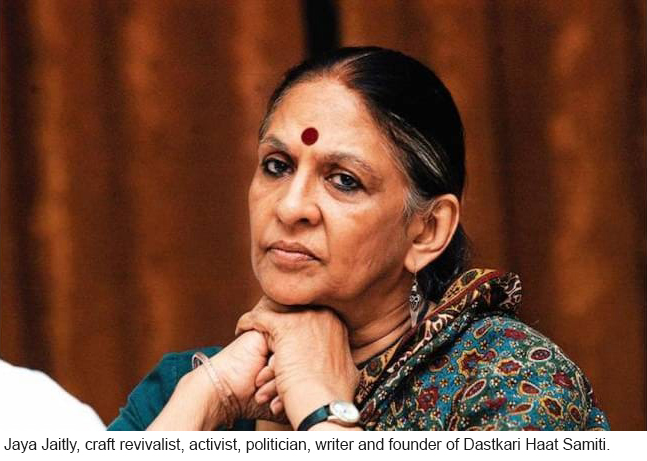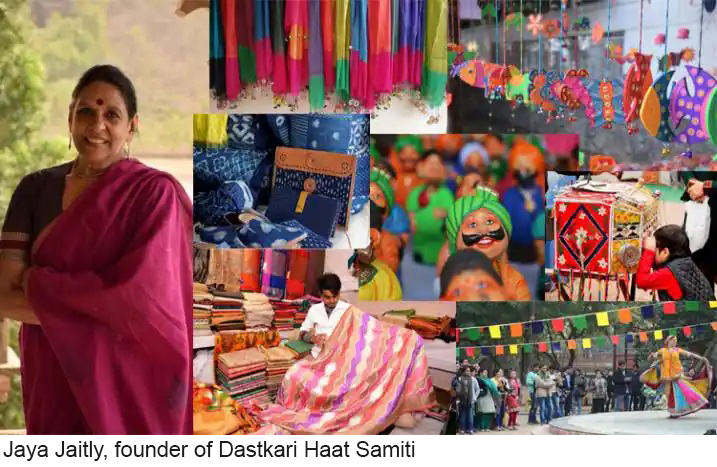
Category: General
Country: India
Region: South Asia
The vision for India’s craft and textile sector in 2047 is to honour and give craftspeople due recognition for being climate warriors in their oneness with nature.
By Geetika Sachdev
August 27, 2023 / 10:16 PM IST
India’s rich craft and textile heritage may be a big talking point today — however, there have only been a handful of true advocates who have consistently contributed to its growth and glory. One such name is Jaya Jaitly, who dons many hats — that of a craft revivalist, activist, politician and writer. She founded Dastkari Haat Samiti, a national association for craftspeople in 1986 and has also been instrumental in the establishment of Dilli Haat in 1994, fashioned on a rural bazaar where the skill of artisans from across India takes centre stage.
A prolific writer, Jaitly has penned titles like Crafts Atlas of India, an ‘atlas’ of India’s crafts, handmade textiles and traditional arts that make up India’s rich cultural history; Crafting Nature, a book that delves deep into the exploration of the gentle harmony between the artisan and nature, and Visvakarma’s Children: Stories of India’s Craftspeople, a hard-hitting piece of work that takes readers into the lives of seven craftspeople engaged in the manufacture of seven different crafts in India, among others.
Even today, the octogenarian continues to hold deep passion and commitment for the upliftment of the craft and textile sector.
In a candid chat, Jaitly opens up about her vision for her industry in 2047 and what it will take to achieve this ambitious dream:

“I envision craftspeople being honoured as climate warriors for their intrinsic oneness with nature in their practice” says Jaitly, adding that the community has not been given enough recognition for this aspect.
A roadmap for the future
Jaitly highlights how there are no short-term concerns in the textile and craft sector. Rather, there’s a collective responsibility to carry forward the cultural heritage the country has inherited, on which the craftpersons’ livelihoods exist.
"We have a double duty of creating livelihoods for the community of artisans. There's plenty of space for those who have a legacy of these heritage skills, because they have not lent them any institution to pay for the transfer of skills," she adds.
"We must give them more respect than we tend to," Jaitly continues.
Each nation has a distinct identity, whether it's the diplomacy power game or strength in craft and textile that is significant for sociological, economic and geopolitical reasons. For India, it's the cultural heritage that gives the country its sound identity.
"When we speak of unity in diversity, craft is probably the best example since it has diverse interpretations. We can't forever give examples of Gandhiji and yoga; we have to give concrete examples of how craft relates to humanity," she elaborates.
In this context, Jaitly brings up the pressing issue of climate change. She believes craftspersons are the real 'climate warriors' who have been one with nature since birth.
"They are people who survive on the nourishment of the environment. The materials they use are organic and natural. When it doesn't happen, they are neither independent nor are responsible for the regeneration of nature," she explains.
These cultural activities and rituals, and philosophical beliefs contribute to India's very consciousness that the Indian government is speaking about.
However, Jaitly highlights that the karigar has been doing this all along.
"We have not given enough recognition to this aspect of the vast workforce. I believe it is our duty to focus on it, in the next few decades," she adds.
"All the talk of climate change ends up in Paris, where funding is largely discussed. Here are people, in millions, not just in India but across the world who rely on ancient craft practices," she comments.
The community of craftspersons has contemporarised their designs, moving ahead with the times. However, they haven't given up on the most intrinsic practices that keep their skill and livelihood alive, says Jaitly.
"It's important to honour these people as much as we honour nature. I've done so many projects, where I've shown every department, whether it's forests or women and child, is interlinked. The farmer and the craftsperson's work depends on the other. These things lead to development," she reiterates.
Taking inspiration from India’s cultural heritage and the skill of craftspersons, it’s equally important for the country to implement infrastructural development using natural, sustainable materials in construction practices.
"In Goa, the structures built in earlier times were of laterite stone, while the northeast has a predominant use of bamboo, but we take so long to recognise it. China is way ahead in this, making floorboards and exporting them. Their companies have also linked up with farmers who cultivate the bamboo; the households are also involved in the process. These links within society are important for development," she advises.
While some changes are happening today in India, these continue to take place at a patronising and secondary level, believes Jaitly.
"It hasn't become a national programme. Some states are proactive about using natural materials in construction practices, but I believe these should be implemented at a national level and forcibly imposed on people. Thereafter, there should be an annual audit of how much natural material is being used in various developmental activities," mentions Jaitly.
Apart from these concrete steps, Jaitly has another piece of advice — to not lose touch with the identity of our cultural heritage, since it leads to the loss of Indian aesthetic.
"By decolonising, one half of us still hasn't changed and all we do is imitate. Everything is a cheap imitation of what is being done abroad. We have excellent examples of ancient building design in India that are elaborate. In fact, the structures based on shilpa shastras or vastu shastra are not mumbo jumbo and still make sense," she says.
On that note, Jaitly recommends against being imitators in the public consciousness. "Even if we imitate, we must take inspiration from countries with a high aesthetic like Japan. Instead, we deride China and still imitate it.. What is it that we have done that is really Indian? There's very little," she points out.
"Either we are harping on our British heritage or trying not to harp, but extolling the beauty of our Mughal structures. Before that, we had various kingdoms and their beautiful temples and forts. What have we done from Independence to now, in terms of a world-class heritage building?" she asks.
In her opinion, “it’s important to have our footprint on the world stage of aesthetics that links to our cultural heritage. That is what we need to work on in the next few decades.”
Courtesy: https://www.moneycontrol.com/news/business/bullish-on-india-business/bullish-on-india-what-will-indias-craft-and-textile-sector-look-like-by-2047-11265281.html
Copyrights © 2026 GLOBAL TEXTILE SOURCE. All rights reserved.